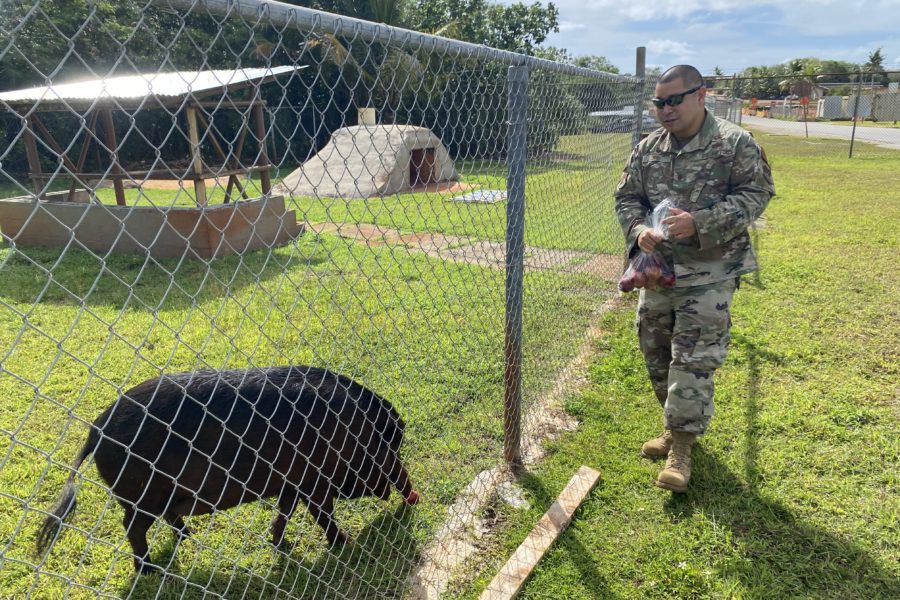ANDERSEN AIR FORCE BASE, Guam—In a small, fenced-in operating location deep in the Pacific theater lives an honorary Airman who snorts at the threat posed by China.
She doesn’t worry about living on Andersen Air Force Base, Guam, surrounded by 4,400 acres of munitions, either. A ready supply of fresh apples weighs heavier.
Not the kind with bruises. This fourteenth-generation Andersen resident will sniff and walk away from sub-par-quality treats.
“Shakey is one of the two mascots in the United States Air Force,” said Maj. Timothy Wu, commander of the 36th Munitions Squadron during a “super special” Air Force Magazine visit reserved for the end of a sweltering reporting day.
The most widely known Air Force mascot is the Air Force Academy falcon. “The other is Shakey the pig,” said Wu.
“Hey, Shakey! Hey, girl!” yelled Wu one muggy June afternoon as he attempted to summon the dark brown animal from the respite of her sleeping quarters below a yellow-flowering Cassia tree.
Shakey waddled her hundred-pound body with feverish quickness across the neatly trimmed grass, past a small wooden lean-to shelter and a miniature replica of a munitions igloo, a “Pig-loo.”
Her agape mouth appeared to salivate as she eyed a plastic sack of apples through the chain-linked fence and motioned her pink snout upward amid excited snorts, as if to indicate that she would like the apples deposited over the fence.
“She is our first female Shakey. She’s a local pig, and she’s awesome. She’s our big girl here,” Wu said with a fond laugh.
High-ranking Air Force officials and distinguished visitors to Andersen pay a visit to the 36th MUNS resident:
“Chief Bass, the Chief Master Sergeant of the Air Force. I’ve shown Shakey to the German Minister of Defense. All folks—they all know Shakey,” Wu said.
The question of Shakey’s namesake, a title passed down from one generation of munitions pig to the next, as thousands of Airmen on rotation care for and celebrate her, is still a thing of lore.
“There’s three rumors,” Wu explained.
Shakey could have been named after the old cargo plane, the Douglas C-124 Cargomaster II. The C-124 was dubbed “Old Shaky” because it tended to shake a lot, even in calm skies.
“Another one was a tech sergeant that drank too much coffee, that was named Shakey,” recounted Wu, describing the second rumor of the name’s origin.
“Another theory is that when they caught the original one, her future was always shaky, because they were going to plan on eating her,” he said. “They didn’t know if they were going to eat Shakey or not, so the future was always shaky.”
A $6,000 yearly budget combined with some local resources covers Shakey’s morale, welfare, and recreation expenses, including food and renovations to her facilities. A wood retaining wall to keep rain out during monsoon season is under consideration for fiscal 2023.
A steady flow of fresh apples, melons, and oranges—which she peels with her nose and teeth—has made Shakey realize her importance to the morale of service members in Guam.
“She is a diva. That’s what she is. She knows what’s up,” Wu explained, recounting the story of a visitor for whom Shakey refused an audience.
“Someone came by, and they’re like, ‘Uh, how come Shakey doesn’t come out here for me?’” he said. “I’m like, ‘Because the last few times, you came here empty handed. So, she remembers.”
Quality is also important to Shakey.
“Don’t give her no spoiled apples, either,” Wu said.
When one service member dropped bruised apples over the fence top, Shakey sniffed them and walked away, leaving the perplexed Airman concerned about Shakey’s health.
“I’m like, ‘Now, then why did you give it to her?’” Wu remembered, shaking his head in disbelief.
“‘He was like like, ‘I don’t know, because I don’t want to eat them.’ I was like, ‘But she knows that, too. She’s not going to—’ He tried to pass off some bum apples, because he wasn’t going to eat them, to the pig,” Wu recounted. “Shakey was like, ‘Oh no, I ain’t doing this.’”
Editor’s note: This story was corrected at 5:28 p.m. Eastern time July 11 to remove a reference to the C-124’s role in the Berlin airlift. The C-124’s maiden flight took place after the Berlin airlift concluded.

